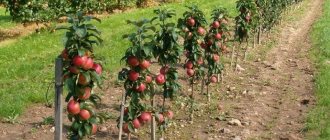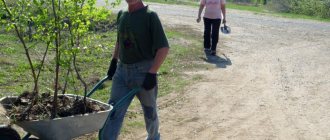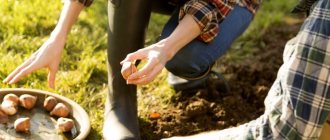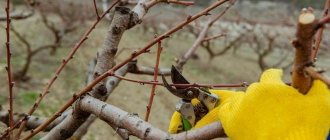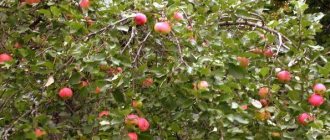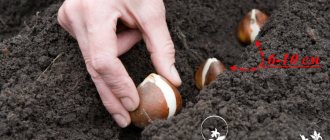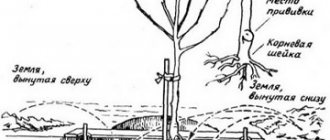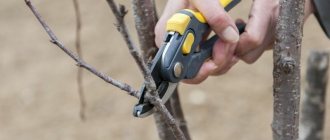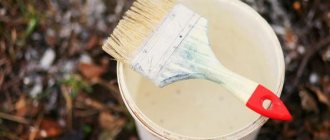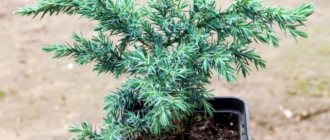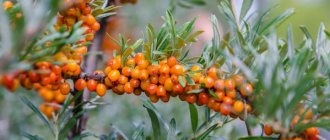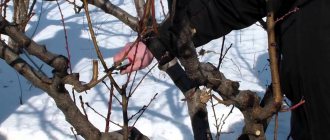Beginning gardeners often hear that the apple tree is an unpretentious plant and care for it should be minimal.
But experts in their field can quickly convince you of the opposite: you need to take care of the apple tree all the time so that the tree remains healthy and delights you with its delicious fruits.
And proper care begins with planting. If you make mistakes at this stage, the young tree may simply not take root in the future. Let's figure out together how to properly plant apple trees in the fall.
Is it possible to plant apple trees in the fall?
The first question that arises for beginners is: “How and when to plant apple trees in the fall?” It is not without logic, because the cold weather is coming soon, and winters in our latitudes can be too harsh.
But, oddly enough, it is recommended to plant apple trees in the fall . However, we should not forget about the characteristics of each individual region.
In Non-Black Earth regions , it is better to choose the early spring months; for Ukrainian regions, the ideal period would be late summer - early autumn, and Ural, Siberian and Belarusian gardeners try to complete this task as early as possible.
Planting an apple tree in the fall is considered the optimal time.
Why is autumn considered the right time?
This time of year is quite humid.
The rainy season usually lasts until mid-November. The air temperature is high enough to start planting a tree. IMPORTANT! You need to plant an apple tree at least a month before the onset of frost, when the foliage has already completely fallen.
Even slightly sub-zero temperatures negatively affect the development of the plant’s root system.
The fact is that before the onset of winter, trees hibernate and all biological processes in them slow down. In this condition, seedlings are better able to withstand digging up and “relocation” to a new location.
It is imperative to give the young tree time to adapt to new conditions before frost hits.
The most important advantage of autumn planting is that the tree will already have time to “get comfortable” in the soil, its root system will become stronger, and in the spring the apple tree will begin to actively develop.
Features of the soil and climate of the Leningrad region
The Leningrad region belongs to the North-Western region. The proximity of the Atlantic affects the climate - it is humid, with frequent precipitation, most of which occurs in the summer. The Atlantic also affects the temperature regime, lowering summer temperatures and increasing winter temperatures. The proximity of the Arctic is affected by a sudden breakthrough of cold Arctic masses, which bring severe frosts in winter, and sharp cold snaps in summer, sometimes even to the point of frost.
The soils in the region are poor podzolic or peaty, often overly moist. The humus layer is thin.
Not every apple tree variety will survive in such conditions, especially if it is a young seedling. The timing of its planting is very important for survival.
Preparing the site
Planting any tree begins with preparing a suitable place . It is worth taking care of the plot for the apple tree in advance, no later than two to three months (it is best to do this in the spring). The ideal area would be one where fruit trees have not grown before.
The depth of the hole is of particular importance for the apple tree..
If the planting site is too deep, air will no longer flow to the root system in sufficient quantities. In this case, the roots may even begin to rot.
A shallow hole will also bring only problems: exposed roots will begin to deteriorate due to exposure to low temperatures.
Watch a video about preparing a place to plant an apple tree:
To form a hole correctly , follow these rules in the sequence suggested below:
- Carefully remove the turf , then the top layer of soil - the most fertile. Fold them separately.
- Remove the next 20-30 cm of soil.
- Dig everything up and carefully level it.
- The depth of the resulting hole should be approximately half a meter, and the width should not be more than a meter.
- Place turf at the bottom (grass side down). This is necessary so that the grass, microorganisms and other “population” of this layer rot and turn into humus, thereby increasing the quality and quantity of nutrients for the young tree.
- Prepare in advance wood ash, leaf compost, stale cow manure (it can be replaced with horse manure, but in no case with bird manure). Mix these ingredients well. They need to be placed in the pit, continuing to mix thoroughly to ensure sufficient looseness and moisture.
Planting an apple tree in a prepared place.
- Be sure to put a mark so that after a while you can find the prepared place. Pay attention to the soil characteristics. If it has a clayey consistency, do not dig the hole too deep. Maximum – 30 cm. But make it wide enough (up to 1.5 meters). This way, nothing will prevent the root system from growing in breadth.
- Be sure to ensure normal flow of air and moisture into the pit. To do this, you need to replace the clay with sand and humus.
IMPORTANT! It is advisable to avoid clay, loamy and sandy soil for planting.
The occurrence of groundwater is also important . Ideal conditions would be in which groundwater would lie no closer than 2.5 meters.
If unfavorable conditions on the site cannot be avoided, it is better to plant the tree on a small mound, the height of which will be about half a meter and the width - about a meter.
These mounds are made from turf and topsoil.
Selecting a location
The choice of territory where the apple tree will “move” is an important aspect that must be given due attention. If it is incorrect and inconvenient for the tree, then you won’t have to expect a rich harvest.
When choosing a site for an apple tree, it is important to consider the following factors:
- the sun should illuminate the entire area well. It is necessary that there is no shading on it;
- a prerequisite is the presence of a barrier on the north side from the wind or draft;
- maintain distance from other trees and buildings;
- the soil should not be swampy or waterlogged. But the minimum occurrence of groundwater is 1.5 m from the ground.
It is better to plant an apple tree on light loamy soil - it is necessary for the full growth and development of the plant. Sandy loam or light chernozem soil type is also suitable. At the same time, the level of acidity is also important - the soil must be neutral, fertile, light, loose, which will allow air and moisture to pass through.
Selection of seedlings
The main criterion for choosing a seedling is its health . Buying a young plant from an unverified person is a big risk. A suitable place to purchase is a special nursery.
It is best to choose a plant no older than two years old for planting. Before purchasing, ask experienced gardeners which varieties grow best in this climate . Give them preference.
Pay special attention to the roots . They should not show signs of damage, mold or mildew. A healthy tree usually has many roots. They are usually of different lengths. This is a normal feature.
If you think the roots are too long, don’t worry, they can be trimmed slightly.
Smooth (this means, without any suspicious damage) bark should be dark brown in color - this is a natural color . The crown of a young tree should already consist of more than 4 branches. The graft should be located approximately 5 cm from the root.
Which seedling to choose
You should purchase seedlings only from reliable nurseries or markets that have proven themselves well (you can check this from reviews of real consumers). But this is not enough; you should approach the issue responsibly. It is necessary to purchase only zoned varietal species adapted to the climatic conditions in the region. If a summer resident does not understand anything about varieties, then be sure to consult an expert.
In markets you can buy seedlings with:
- open root system (ROS);
- closed (ZKS).
Planting the latter is easier.
On a note!
Container-type seedlings with ZKS are allowed to be planted in spring, autumn and even summer. But in the heat and drought of summer, it is right to refuse planting, since it will be problematic for the plant to take root in such negative conditions.
Recommendations for choosing high-quality, healthy apple seedlings:
- At the bottom of the trunk there should be a visible grafting site without injury or peeling of the bark. The presence of a graft indicates that this is definitely a cultivated plant, not a wild one.
- It is necessary to select only healthy specimens, those that do not show signs of damage, diseases, pests, or cracks. The bark, trunk, branches, rhizome must be whole.
- The optimal age is 1-2 years; a plant older than 2 years is not suitable.
- Suitable height is 1-1.5 m.
- You should be careful about an excessively tall seedling with an abundance of greenery, since such a young plant was deliberately fed with nitrogen, which means that the growth processes in it have not been completed, and the fruit tree will not survive the cold.
- Very low and weak specimens are also not suitable, since such seedlings have been poorly or improperly cared for, or they suffer from some kind of disease, which means they will not take root.
The rhizome must be well formed (central root and always lateral roots). Size - approximately 200-250 mm. It should be:
- not injured;
- without rot, growths, formations.
The roots must be flexible.
If you purchase a sample with ZKS in a container, then you need to check whether it is of the container type. To do this, you need to take it by the trunk and shake it a little; if the plant sits firmly in the soil, it means it is a container type, and not firmly transplanted not so long ago. Only with the right choice of seedlings will the planting of apple trees in the Leningrad region be of high quality.
Proper planting of an apple tree in autumn
Before proceeding directly to planting, the tree must be placed in water for a day. This is necessary to avoid drying out the root . Take a close look at the bark of the apple tree.
The place where the color of the bark is slightly darker than in other places is the root collar, which should be located slightly higher in ground level than the rhizome.
When an apple tree is planted, the neck must be covered with a little soil. However, over time, the soil settles and this place is exposed.
The grafting site cannot be covered with soil . It should be raised by at least 5-9 cm. Compacting the soil during planting is prohibited, because this will interfere with the free access of oxygen to the root.
Immediately after planting, you need to tie the tree to pegs . Their number depends on climatic conditions. The main thing is to ensure the safety of the young tree and protect it from breakage.
Pay attention to the color of the seedling's bark.
For this you need to use either wet rags or films so as not to harm the bark. Even in rainy weather, the seedling needs to be watered after planting.
IMPORTANT! 4 meters is the ideal distance at which the apple tree should be located from other fruit trees.
Choosing seedlings
Important: choose seedlings without leaves. If they are dug up too early - before they shed their leaves - then there is a high probability of the seedling dying
Water evaporates through the leaves; without constant replenishment, such a seedling will simply dry out. We sell only those seedlings that fully meet all requirements. However, in other stores and markets you can find low-quality goods. Once again: it is better not to buy seedlings with leaves.
There must be several massive branches, preferably thin shoots.
Also, pay attention to height. At least one and a half meters, but not too high
Ideally, as tall as you are, this is the best option.
Let's summarize. What should an ideal seedling be like?
- No damage or traces of pest activity.
- Quite tall, with developed branches and an extensive root system.
- Without leaves and in appropriate packaging.
We carry out wholesale supplies of seedlings for gardening partnerships and other business entities. We also sell seedlings at retail. Rest assured, we send only ideal seedlings to our clients.
How to plant with a closed root system?
An apple tree with a closed root system is a seedling purchased directly in a pot or container. Such a plant requires special treatment.
What are the rules for planting an apple tree in the fall in this case?
- You need to prepare a hole (you need to follow the rules above). Its size should not exceed half a meter in depth and a meter in width.
- The bottom layer, which is not fertile, must be removed . Instead, fill the hole with top layers of soil, ash and fertilizers (optional).
- In this hole you need to make a hole the size of a pot or container.
- Turn the pot upside down. Carefully, holding the seedling together with soil, remove the container. To make the task easier, water the plant first. This way you minimize the risk of injury to the root system.
- Place the seedling along with the soil in a hole so that the level of soil from the pot coincides with the level of soil in the hole or rises slightly above it. It is impossible to fill the soil from the pot, so as not to displace the correct position of the root neck.
- Place a stake next to the hole to secure the young tree.
- Fill the free space between the hole and the soil from the pot with soil, watering generously.
- Lightly compact the soil with your foot along the perimeter of the hole (this must be done very carefully, the toe should be facing the seedling itself).
Tie the seedling to a stake.
Subtleties of planting a seedling
Seedlings with open and closed roots are planted differently. But there are patterns that are common to all types of seedlings.
- Apple trees grow well where there is a lot of sun and there is no stagnation of air. Therefore, lighting and ventilation are mandatory. An exception is made only for dwarfs with a weak root system. Where they will grow, strong winds are undesirable.
- Apple trees do not tolerate stagnant water.
- The groundwater level should be below 3 m for tall varieties, 2.5 m for semi-dwarf varieties, 1.5 m for dwarf varieties.
- The distance between tall trees is chosen to be at least 5 m. Between medium-sized apple trees - 4 m, and 3 m between dwarfs.
- The size of the planting hole is determined by the type of soil. If the soil contains a lot of clay, dig a hole at least 1 m in diameter, but not deep; it is enough to go 40 cm deep. A drainage layer is required. For other types of soil, dig a hole with a diameter of about 90 cm, deepening it to 60 cm.
- You need to dig a hole and fill it with soil in advance, no later than 14 days before planting, so that the soil settles.
- To fill the hole, a couple of buckets of well-rotted humus, 150-200 g of superphosphate, 150 g of potassium chloride or sulfate are enough; they can be replaced with 1 kg of ash. These components must be mixed well with the top layer of soil removed from the hole and filled ¾ of the way. Fresh manure is not used for planting. Peat soils are improved by adding clay and sand, and sandy peats and clays. Sometimes a handful of grain, preferably sprouted, is placed under the roots of a tree. It is believed that this contributes to better survival of the apple tree seedling.
- The root collar should not be buried in the soil; it should be level with the soil surface or a couple of centimeters above it.
The root collar connects the roots and the trunk of the tree. Do not confuse it with the place where the vaccine was given, it is located above - Be sure to provide a landing peg, or better yet, a narrow board, well reinforced. It will become a support for the seedling; place it facing south. This way she will protect the stem of a young apple tree from the scorching sun.
Question about fertilizers
When planting apple trees in the fall, it is useless to use large amounts of nitrogen fertilizers. It is better to apply them in the spring, when you need to stimulate plant growth.
Fresh manure (horse or cow) should be applied to the very bottom of the planting hole and separated from the root system with a layer of soil. But it is best to use already rotted manure in combination with compost, ash and sand.
IMPORTANT! Fresh manure should not be overused when planting young trees. When it gets into the soil, it releases ammonia and hydrogen sulfide, thereby poisoning the rhizome.
Of the mineral fertilizers, it is best to focus on phosphorus and potassium fertilizers.
It is also convenient to buy fertilizers with the name “Autumn” . They usually contain sufficient amounts of phosphorus, potassium and a small amount of nitrogen.
very important to reduce soil acidity when planting in autumn . This is facilitated by adding dolomite flour, slaked lime, and meadow marl to the soil.
These substances cannot be used together with phosphorus, because they make it difficult to dissolve.
If you are planning to plant a garden in a new area with infertile soil, begin fertilizing the soil at least a year before planting trees . It is best to start cultivation 2-3 years in advance.
Landing
When choosing apple tree varieties suitable for Siberia and determining planting dates, you need to take into account the characteristics of these regions: long winters, too close groundwater, as well as a short growing season for plants.
The ideal time for planting seedlings in Siberia is spring.
There are no specific calendar days for planting apple trees in the spring, since the winter can be long, in which case you need to wait until it warms up and the snow melts. Gardening activities can begin as soon as the ground becomes soft. Early planting has its advantages: the seedling's growing season and time for adaptation are increased.
Watering
When we plant an apple tree in the fall, we need to understand that the first watering is most important for the further development of the plant. It not only provides the root system with sufficient moisture, but also compacts the soil.
Pouring water in one stream directly under the seedling is very harmful. For these purposes, use a simple watering can.
If the first watering should be plentiful, then do not abuse the amount of moisture in the future. It provokes the appearance of a crust near the rhizome, blocking access to oxygen.
Use a watering can for watering.
IMPORTANT! It is best to water a young apple tree in the evening.
Care after landing
On a note!
Columnar apple trees are the most convenient for the Leningrad region. They do not grow in width and are the easiest to care for. If necessary, the planting can be covered completely for the winter.
During drought, seedlings need to be watered weekly. In the future, 4 times irrigation per season will be sufficient. After each watering, the soil needs to be loosened. At first, no fertilizer is required. For growth, the substances added during planting are sufficient. Pruning is required annually. It is necessary to remove all damaged and diseased branches. Up to 5 years, the plant also needs formative pruning.
It is not difficult to grow apple trees in the Leningrad region. The main thing is to follow all recommendations for planting and care.
Proper care
In addition to the question of how to properly plant an apple tree in the fall, the question arises about further care of the seedling. Young apple trees require regular watering and pruning . Pruning is necessary so that the tree begins to bear fruit faster and is more resistant to frost.
When planting at any time of the year, the apple tree is pruned only in the spring .
The plant should be pruned for the first time in the second year after planting. This is done in early spring before the buds begin to swell. At this time, you need to trim the crown and remove dried branches.
New branches will begin to grow faster and the plant’s productivity will increase.
Mulching also plays a big role in caring for a young tree. It is best to do this with stale horse or cow manure or humus.
There is no need to cover a newly planted plant with a large layer of manure. A small amount, covered on top with mown grass or straw with a layer of 5 cm, will be enough.
Under this layer, ideal conditions will be created for the life and reproduction of earthworms and other living organisms, which will provide good conditions for the apple tree.
The best varieties for the Leningrad region
You need to find out in advance which apple trees are best for Len. Regions. The success of the procedure also directly depends on the correct choice. Not all varieties can withstand sudden temperature fluctuations and harsh winter conditions. The best option is zoned varieties. Such plantings will definitely be able to grow and bear fruit in unpredictable climate conditions.
Summer
Summer varieties ripen the earliest. They are ready for harvest in June-July. The most popular variety is White filling. The fruits are white, and after full ripening the skin is almost translucent. The seedling has increased resistance to frost. It begins to bear fruit at 5-6 years. The weight of apples is 100-150 g. With age, the fruits become smaller. The harvested crop is not suitable for transportation. The fruits are stored for about 2 weeks. Suitable for consumption and preservation.
Summer varieties also include Memory Lavrik. The fruits are light. The weight of each apple is about 200 g. The fruits contain a large amount of vitamin C. The seedling tolerates sudden changes in temperature very well.
Autumn
Autumn varieties are dense and transport well. These include the Melba apple tree. The variety is zoned for almost the entire territory of Russia. It has high taste qualities. The plant has good frost resistance. The first harvest can be harvested already in the 4th year. The Uslada variety is semi-dwarf. Has a compact size. The taste of the pulp is dessert. The planting produces its first harvest in the 4th year. Winter hardiness is high.
Winter
Winter varieties include:
- Antonovka;
- Gift to Grafsky.
Antonovka has high resistance to frost, as well as good taste of the fruit. There is a possibility of scab infection. The gift to Grafsky is frost-resistant. The weight of the fruits reaches 150-200 g. The harvested crop can be stored for about six months. This is due to the high density of apples.
Features of planting in frost
It happens that it was possible to buy a seedling too late. Many are tempted by lower prices. According to the rules, all deadlines have been missed. In this case, is it possible and how to plant an apple tree in the fall when it is frosty? Are there any technologies for planting trees at sub-zero temperatures?
Important! Experts advise it is better to postpone all activities until spring, and at this time make sure that the seedling remains viable before the onset of the warm season.
You can store a young plant in a cool cellar. To do this, you need to place the root system in a container with peat or sawdust. In the room itself, the temperature should not fall below zero. If you water the apple tree at least once a week, it can be planted in early spring.
Digging in apple tree seedlings until spring.
In snowy regions, seedlings can also be stored under a sufficient layer of snow cover (provided that the seedling is well packed). Snow will not allow the temperature around the plant to drop below its vital level.
Planting bare-rooted seedlings
Seedlings with closed roots are completely ready for planting, but specimens with an open root system are subject to pre-planting preparation.
How to properly plant an apple tree with an open root system in the fall:
- Shake off the roots or dip them in water to remove old soil.
- Trim off any damaged, broken or diseased roots. Pruning is carried out with a sharpened and disinfected tool.
- 24 hours before planting, place the roots of the seedling in water, or better yet, in the Kornevin solution.
- Before planting, dip the roots in a clay mixture - now the bare-rooted seedling is completely ready for planting.
- Form a hill in the hole, place the roots on it, straighten them, and cover them with fertile soil. When filling the hole, shake the seedling from time to time to prevent the formation of air bubbles.
- Compact the soil, moving from the edges of the hole towards the center. Use your feet - place them along the radii of an imaginary circle.
- Water the seedling with warm, settled water. First, pour in one bucket of water. Form a side around the trunk - at a distance of 0.5 m. The height of the side is 10 cm. Pour two more buckets of water under the seedling.
- Mulch the soil in the tree trunk circle with humus or peat. Layer thickness – 10-15 cm.
- Pinch the top of the tree. This will stimulate the growth of side shoots.
- Insulate the tree before frost. Wrap the trunk with burlap or other covering material. If it suddenly gets warmer, remove the shelter, otherwise the tree will grow again.
How to plant an apple tree in the fall: a step-by-step guide
- Place the seedling in the ground soon after purchase to avoid drying out the root system.
- The belief that a large seedling will take root better is a myth. In fact, they adapt much worse to new conditions.
- Trees should not be planted in a hole that is not properly prepared. Be sure to use fertilizers. However, mineral fertilizers should not be abused. There is a risk of burning young, immature roots.
- After planting, the young plant must be watered immediately. This is necessary not only to saturate the tree with nutrients, but also to compact the soil to the required state. For this purpose you need to use a watering can. If the season is not rainy, then before frost sets in, the tree needs to be watered regularly (at least once a week). Until the soil in the planting hole is compacted enough, you need to use watering cans. Only then can you start using watering from a hose.
- Typically, apple trees are recommended to be planted at a distance of at least 4 meters from each other. For low-growing trees, this distance can be reduced to 3 meters.
Selecting a site for planting
The ideal place for growing Siberian apple trees would be a site on the south side, located on an inclined surface, which will prevent stagnation of moisture and rotting of the root system.
Basic requirements for the place where apple trees will be planted:
- good sunlight exposure;
- location that excludes the penetration of gusty winds;
- saturation of the soil with nutrients necessary for life.
If there are no conditions favorable for growing apple trees in a particular area, you can provide the trees with everything they need on your own: add fertilizer to the soil, build a fence from the wind, and protect them from groundwater using drainage.
Features for different regions
We already mentioned at the beginning that the specifics of how to plant an apple tree in the fall largely depend on climatic conditions.
- In the Moscow region, the best time to plant apple tree seedlings is in the fall, from the third ten days of September to the end of October. In November, frosts may already begin in these places, and for young plants they are often disastrous.
- The Leningrad region is known for the poverty of its soils, so special attention should be paid to fertilizing the planting pit. The best time for gardening is late September - early October.
- In central Russia, you also need to take into account the time of the first frost. Mid-September - the first two weeks of October would also be ideal. However, due to the weather, it is sometimes better to postpone planting an apple tree until the spring.
Planting times depend on the region.
- In southern Russia, this period may extend until early November. Always keep an eye on the weather forecast though. No one is canceling the sudden onset of cold weather.
- the frosty Siberian winters . In these regions, it is better to postpone planting an apple tree until early spring.
- is no less destructive for seedlings . Most likely, they simply will not have time to adapt to the new land, and the early frost will destroy them.
Advice! Experienced gardeners recommend that planting apple trees in the fall in Belarus should also be completed as early as possible. It is advisable to complete the entire process before mid-September.
Ukraine is famous not only for its fertile soils, but also for favorable conditions for autumn planting of apple trees. Autumn seedlings will take root better than spring ones in the southern regions of the country.
Features of growing apple trees in the Leningrad region
When choosing a place for an apple tree, pay attention to the climatic conditions and soil characteristics of the garden plot. Apple trees do not like acidic soil and do not tolerate close proximity to groundwater.
For most areas of the Leningrad region, preference should be given to low-growing seedlings grafted on a winter-hardy rootstock. Tall apple trees can be planted using special technologies.
Apple tree planting
It is better to plant an apple tree in early spring, in late April - early May. A place for seedlings is prepared in the fall, choosing a well-lit area of the garden that is protected from the wind. In spring, it is recommended to purchase seedlings with a closed root system.
Next, we will look at the features of planting apple trees on soils of different compositions:
- If the site is dominated by heavy loams or clay, the apple tree is planted on a hill.
If the site is dominated by clay, you need to plant an apple tree seedling on a hill
- If the site has sandy soil, you need to dig a planting hole 80x80x80 cm, lay drainage (pieces of brick, a layer of stones) on the bottom, place sphagnum moss on top, and then fill the hole with fertile soil (add compost, humus).
When planting an apple tree in sandy soil, you need to prepare a hole.
- On light loams and sandy loams, the apple tree should be planted on a flat surface. To do this, remove the top layer, turn it over with the turf up and lay it around the seat.
On light soils, instead of a planting hole, make a border of turf
General recommendations for all areas:
- When planting, add ash (2 cups) to the hole and pour in a bucket of water.
- The seedling is placed so that the grafting site is 2 cm above the ground, and carefully sprinkled with fertile soil.
Video: planting an apple tree with high groundwater levels
How to care for an apple tree
Caring for an apple tree in the Leningrad region includes the usual steps:
- watering;
- pruning;
- feeding;
- disease and pest control;
- preparation for winter.
The region receives sufficient rainfall, and only in dry summers do apple trees need additional watering. Tree pruning and pest and disease control are carried out according to general rules.
Most of the territory is dominated by poor soil, so the trees need regular feeding. Mulching the tree trunk with organic fertilizers has a positive effect on the growth and development of apple trees. In autumn, it is useful to apply ash under the crown (2-3 cups).
Particular attention should be paid to preparing plants for winter. At the end of the season, the following work is carried out:
- To protect the root system of low-growing apple trees from frost, the tree trunks need to be mulched with peat.
To protect the root system, tree trunk circles need to be mulched with peat
- To protect the trunk from rodents and protect the tree from frost, you can use spruce branches.
To protect against rodents, the trunk of the apple tree is covered with spruce branches.
Selection of varieties
Columnar apple trees, which appeared some 40 years ago thanks to the efforts of breeders, are very popular among gardeners.
Like other types of fruit trees, such apple trees are recommended to be planted in spring or autumn (no later than the end of September).
The survival rate of dwarf apple trees also depends on the time of planting. In autumn, such seedlings need to be replanted when growth partially stops and some leaves fall off.
Particular attention should be paid to ensure that the roots of the tree do not remain exposed to the air for a long time. This can cause them to dry out. Otherwise, standard rules should be followed.
usually planted with two-year-old seedlings , however, one-year-olds can also take root well.
To do this, they need to be booked. When planting in autumn, this procedure is carried out in the spring.
Planting an apple tree in soil with a high clay content
No matter how hard you try to make drainage in a hole dug in clay, there is always a danger of the seedling dying due to stagnation of water. On such soil, it is advisable to plant young apple trees superficially, without digging a hole for planting. This method is especially good if the seedling is grown in a pot.
Prepare the soil for backfilling as indicated above. We prepare the soil by digging and removing weeds. We put hay, completely rotted sawdust or fresh grass on top of it. We install the peg. Add some soil and compact it. In the center we place a layer of turf approximately 40 by 40 cm, grass side down. We place the seedling on it, freeing it from the container in which it grew. We fill it with prepared soil, spilling it and compacting it. It should be a gentle slide. We make a hole for watering, water, mulch.
Even in the conditions of the Leningrad region, it is quite possible to plant an apple orchard during autumn planting. The main thing is to choose seedlings of released varieties and good quality that have completed the growing season and plant them correctly.
Seedling preparation
When the seedling has already been delivered to its new place of residence, it must be properly prepared immediately before planting. There are several important measures that will help the apple tree take root as quickly and painlessly as possible.
Root pruning
Before placing the plants in the ground, you need to trim the roots a little. This is also done so that they fit more conveniently on the site, and also such pruning will stimulate a greater appearance of lateral shoots on the roots, which will make it easier to get used to the new soil.
The roots need to be trimmed before planting.
Trimming the above-ground part
To balance the balance between the roots and the crown, sometimes you will have to trim off the above-ground part. Long shoots are cut off a little, only by a third, and some even by one bud. This is done so that after planting the apple tree does not spend a lot of effort on forming branches, but takes root first.
Soaking the roots
Before planting, the roots need to be soaked in a clay mash.
Before planting the seedling, it is necessary to stimulate the roots. To do this, you need to place them in a container with water for 12 hours before the procedure. Some gardeners also advise adding a little Kornevin to this water, which will help speed up the process of establishment and growth of the young seedling.
Climate Features
Growing apple trees in the Urals is difficult due to the harsh climate. It has a typical mountain climate. Precipitation is unevenly distributed.
The climate of the Urals is varied. It directly depends on the specific place of residence. On average, winter temperatures range from -16-25 degrees. In summer the temperature may vary. There is a chance of heavy rain.
There is moderate humidity in the Urals. The annual norm is about 700 mm. The climate is strongly influenced by Atlantic air masses. Winter is long and can last up to 8 months. Spring and autumn are unexpressed and short-lived.
Possible errors
There are several mistakes that gardeners make:
- Feeding apple trees planted in autumn with nitrogen elements. They cannot be introduced, because they stimulate the growth of vegetative parts, and in the fall this is undesirable, young shoots often die.
- Lack of watering after planting. Although it often rains in autumn, it is necessary to ensure that the soil is properly moistened.
- Wrong choice of timing. We can be reminded of this forever. The main thing is that at least 3 weeks remain before the onset of cold weather; during this period the crop can take root.
Landing dates
The timing of autumn planting of apple trees is determined by the climatic characteristics of a particular area. Thus, in the southern regions of Russia the most favorable period is from the end of September to the beginning of October. In the north of the Russian Federation, in the Urals, and in Siberia, autumn planting must be completed in September.
The main landmark for the beginning of the autumn planting of apple trees in the garden is the fall of leaves.
Preparing the planting hole
The planting pit for the autumn planting procedure is prepared at least 3 weeks in advance, but if possible, it is better to prepare it in the spring. Its size depends on the condition and size of the root system. Usually it reaches 70-80 cm in diameter and the same depth.
In order to lay the foundation for normal growth, it is necessary to add humus, peat, compost, wood ash, mineral fertilizers and superphosphate to the fertile soil . All this is left for cooking and spilled with water.
The planting hole must be prepared in advance.
Preparing for winter
The disadvantage of the climate is the unstable winter weather. After severe frosts, a thaw may begin, and then the thermometer readings will drop again. Of course, such conditions can affect the trees.
Young apple trees need to be covered for the winter. Wrap tree trunks with burlap, bags, fabric or other insulation. If sudden warming suddenly occurs, then it is better to remove such shelter. From an excess of heat, the tree will awaken and begin to grow, and a sharp cold snap will negatively affect the condition of the apple tree.
Tree trunks are whitened. This protects the bark from sunburn, rodents and frost.
The soil is mulched at the end of the seasonal work. Do not use spruce branches as mulch; it can acidify the soil and is also a carrier of rust.
Planting scheme
A fruit tree will grow successfully in Siberia if the planting process strictly adheres to technology. The basic principles of planting are as follows:
- The best option for the climate of harsh regions would be to plant young apple trees in a hill. With the onset of warm weather, the seedling will have the opportunity to quickly warm up, which will prevent rotting of its root collar. It is best to prepare the hill in the fall; its recommended height is 30 cm.
- In the spring, pour a small amount of wood ash and a bucket of compost onto the prepared hill, and then mix everything with the soil.
- Plant the tree so that its root collar rises slightly above the soil level.
- Water the seedling using 3 buckets of well-settled water.
- Tie the planting to a stake driven nearby so that the wind does not break it.
- Perform mulching. For this procedure you need to use organic substances. The best options would be hay and straw, since microorganisms that feed the apple tree actively develop in such an environment.
